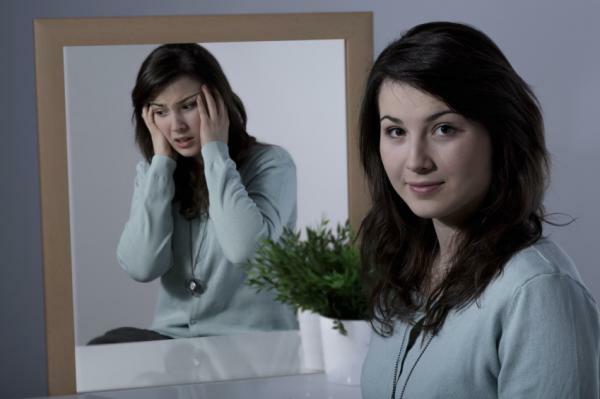
Bipolar disorder is a mental illness that causes changes in mood. We speak of bipolar because there are two poles, one where depression predominates and another where mania or hypomania predominates. This means that the person experiences periods alternately or sometimes at the same time. where symptoms of depression appear (being sad, dejected, with feelings of worthlessness, not wanting to do anything, with catastrophic and extremely negative thoughts, tired, etc.) and the other side of this disorder is mania, so the person also experiences its own symptoms (You feel capable of doing everything you set out to do, which leads you to take great risks, has excess energy, euphoria, irritability, hyperactivity, is extroverted, etc.). Bipolar disorder is quite a serious problem and currently 1 in 15 people have it.
In this article from Psychology-Online: bipolar disorder - symptoms in women, we are going to know in more detail what this disorder consists of, the types that exist, what are the symptoms of bipolar disorder in women, the consequences it can bring and the treatment that should be followed to get over it.
Index
- Bipolar disorder: types
- Symptoms of bipolar disorder in women
- Consequences of bipolar disorder
- Bipolar disorder: treatment
Bipolar disorder: types.
Type I
The person experiences at least one manic phase, which has lasted more than a week. Some people may only experience manic phases, however most will also have depressive episodes. For example, the person may feel sad, not wanting anything, stay in bed all day and suddenly wake up and feel like the happiest person in the world. world, talking to people, doing business, dancing, singing, etc., or on the contrary being in a manic and effusive state and suddenly finding yourself depressant.
Type II
The person experiences more than one severe depressive phase but only moderate manic or hypomanic phases. Generally, it is less severe than type I.
Cyclothymia
It is characterized bychanges in mood, which are not as intense as in bipolar disorder. However, these can last longer and can eventually turn into full-blown bipolar disorder.
Symptoms of bipolar disorder in women.
This disorder is presented by both men and women, the difference is that mania predominates more in men and depression more in women. Women are often more vulnerable due to hormonal changes. It has also been found that there is an increased risk of bipolar type II disorder in women. Some of the symptoms of this condition in women are the following:
- They present a greater number of depressive symptoms.
- More likely to have suicide attempts.
- Anxiety.
- Eating behavior disorders may appear.
- Pregnancy increases the symptoms of bipolarity.
- Irritability.
- During the manic episode, they may show an increase in self-esteem and it is glimpsed in verbiage (tendency to talk continuously without stopping).
- Weight gain due to inactivity.
- They experience the worst mood swings during menstruation.
- They may experience relapses within a period of 3 to 6 months after delivery.
- During the postpartum period, psychotic disorders may appear (the person may experience delusions and visual or auditory hallucinations).

Consequences of bipolar disorder.
When the person suffering from this disorder does not receive treatment, they can have serious complications in one or more areas of your life. Some of these complications are usually the following:
- Economic problems because when they are in periods of euphoria they can make large expenses and unnecessary investments.
- They are more likely to have high-risk sex in high-risk episodes, which can lead to sexually transmitted diseases and unwanted pregnancies.
- Problems related to substance abuse such as alcohol and drugs.
- Legal problems, since they may feel that they are capable of achieving everything they set out to do and take many risks without thinking about the possible consequences.
- Problems in the couple's relationship due to sudden changes in mood and lack of understanding of this condition.
- Low school and academic performance. These people can do their jobs excellently when they are in a not-so-euphoric state. However, when depressive episodes appear, they can even drop out of school or work.
- Sleeping problems.
- Isolating themselves because they can have problems with other people, especially women, since in depressive states a great feeling of loneliness usually appears.
- Lithium is a mood stabilizer that is generally used to treat this condition. However, this causes women to have a higher risk of developing problems with hypothyroidism
Bipolar disorder: treatment.
There are things that a person with this disease can do to ensure that her moods do not end up turning into episodes of depression or mania. However, all people with this type of disorder necessarily need to be treated by a professional. Treatment consists of the following:
Medication
The administration of some drugs is necessary to maintain stable mood and control manic and depressive episodes. Lithium is a widely used mood stabilizer that can be used to control both manic and depressive phases. Lithium treatment should be administered initially by a psychiatrist, since for to work requires taking a dose that is not too low or too high because it may be toxic. However, once the correct dose is established, the GP can administer it. Lithium treatment can have unpleasant side effects but these tend to go away over time.
The psychiatrist also usually administers valproate sodium and olanzapine. On the other hand, the carbamazepine it is indicated if you have rapid and frequent changes in mood. Sometimes, a combination of different medications is necessary, depending on the improvement that is achieved with each of them. Generally, an antidepressant medication is usually added to any mood stabilizer.
Psychotherapy
The cognitive behavioral therapy It has been shown to be beneficial when supplemented with medication to treat these types of conditions. This therapy consists of approximately 16 sessions, which will be divided into a period of 6 to 9 months. Among the main goals of this therapy are to provide information to the person receiving treatment and family members about of bipolar disorder, help the person to identify the moments in which she begins to change her mood, applying techniques to prevent her from starting to have manic or depressive episodes and help her face and solve the problems that arise in her life daily.

This article is merely informative, in Psychology-Online we do not have the power to make a diagnosis or recommend a treatment. We invite you to go to a psychologist to treat your particular case.
If you want to read more articles similar to Bipolar disorder: symptoms in women, we recommend that you enter our category of Clinical psychology.


